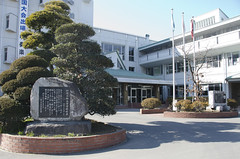
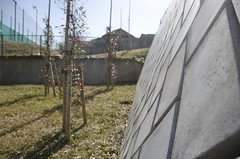
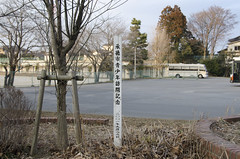
So, Nick, the Torrance Delegation has come and gone, blown in and out like the first spring winds1
1Note that Japan has a term for the first wind storm of the spring, 初風 (はつかぜ). This season's first wind with gusts up to 60kph over three days. With it came the season's first aerosol pollution and yellow sand from across the Japan Sea.
. Over that time there had been more than one long day of sightseeing, more than one high-stakes political dinner, and more than one parade of speeches (in two languages). But there was only one Ichikashi Presentation, and only one Ichikashi Campus Tour.And while I feel like we did an admirable job, the gravity of the event, in terms of both the ELT-program’s
2New official title: 外国語講師.
2 as well as Kashew and my own reputation, does warrant some reflection.I will spare you the nitty-gritty of the specific review; rather, I want to talk about the pre-planning strategy.
Determining scope based on perceived needs.
Obviously, it was important for us when considering what kind of presentation to give to the delegation to determine what kind of information the delegation would find relevant and interesting. Of course all of the standard information had to be there (such as a brief history of the campus and curriculum), but it would be the inclusion of and emphasis on information that they would find unique or otherwise unexplained that would make the presentation feel like a worthwhile expenditure of their time.Thusly, we were required to ask of ourselves some very basic questions: why did the delegation specifically request to see a Japanese school on this trip? what other places and cultural activities would they participate in before (and after) coming to Ichikashi, especially those regarding forums of education? and what expertise and interest would the delegates bring with them that would influence the types of questions they would have or need answered?
Such questions were used to better anticipate the types of information that would most likely be of interest as well as earmark what information would be redundant and, therefore, could be glossed.
In looking at their schedule, we realized two things: 1) they were going to be very busy and, 2) coming to Ichikashi would be their only opportunity to see a Japanese school first hand.
And while the first point allowed us to predict that fatigue would be a major factor in our presentation3
3Which was scheduled to occur in the late afternoon before a mayoral banquet.
, encouraging brevity, the second allowed us to tailor our presentation to spend a majority of our time illuminating what it means to be a high school student in Japan from the administrative/programmatic perspective as well as illustrate activities and events that define Ichikashi life.This was particularly relevant after reviewing the list of attendees. We found out that most of the delegates were from the Torrance City Council (including the mayor and a former mayor), and a good number had spent many years of service in local public education (including a former member of the board of education as well as the first Ichikashi ALT). We would then have to make sure that our presentation spent a good amount of time on educational politics.
So, with that being said, we knew what they would most likely be interested in: information regarding the administrative and structural differences in education between Torrance and Kashiwa. We then knew we had to talk about things like Municipal v. Prefectural v. National funding, open enrollment, and 10-year teacher rotations, in addition to the local processes of homeroom and classroom construction (both literally and figuratively).
And as TSCA representatives, Kashew and I afforded an insider’s working knowledge of Japan, and would thusly be expected to act as a cultural conduit through which the delegates could ask cultural questions without any reservation or fear of offense.
Discerning the disparity among needs.
And yet, even with this information prepared in advance, we were met with a bit of reticence in our first committee meeting. And while I will spare you the grosser details, we should let it suffice to say that what was at odds between us, as presenters, and them, as administration, was an unstated gap of perceived needs. That is the administration had some concerns that were not satiated by the outline laid out before them.And this is fair. But it also made some of the people on the presentation-side a little upset as they felt like their ideas were left ignored in favor of a pre-decided administration-derived plan. They felt it was a waste of time for us to go to an "ideation" meeting to discuss needs when in reality we ended up just being told what our needs needed to be by the administration.
But I see it like this: an open forum of discussion is not democratic, like we pretend democracy to be. It is, after all, autocratic when a boss is involved. The openness of the forum certainly allows for all needs to be aired and made known, but these needs are not equal but are hierarchical. And while a need brought up by one of lower standing may be elevated by those higher than him as previously unconsidered, no particular need can supplant those of the boss without first satiating that need.
That is to say, simply, such meetings are a sale pitches: one must distract the potential buyer from his present concerns before supplanting them with concerns of your own making, for which you can then sell your own solution.
Bridging the gap.
Especially as the presentation was going to be offered to local Kashiwa officials as well as the Torrance Delegation, it became quite clear early on that one of the most important needs of the administration was to affirm the many ways that Ichikashi is unique among it's "competitors" (the 県立, 国立 and 私立 schools in the 関東 area). This is a valid need that could not be ignored, and one that would probably be of passing interest to those involved with TSCA. So the whole second half of the presentation was dedicated to the accolades of the various educational and club programs on campus.This was a felt need that was easily satisfied and should have been included from the beginning. But there were other issues that were closely tied into this.
For example, in the initially proposed itinerary, very little time was afforded to a campus tour as such a thing was considered very unnecessary. Rather, the bulk of the two hours the delegation would spend at Ichikashi was allocated to a presentation about Ichikashi.
The argument that was presented, repeatedly, was that the delegation did not travel 5000 miles to Tokyo and 40 minutes by bus to come to Ichikashi to be shown pictures of Ichikashi.
After this proposition's initial failure, I felt like continuing to repeat this was the wrong tact to take.
Essentially, the best approach to moving a buttressed wall is not to push against it, but to discern which direction the buttress leans and pull in agreement to that plane. What we had to do was discern why there was hesitance in offering a tour and satisfy that concern before we could replace it with our own.
The interesting story that came out of it was the story we led off with in the tour:
This classroom is 2I. You may be wondering why we decided to show you this room. After all, there are no decorations and so it is virtually indistinguishable from every other classroom that we just passed by. Actually, that is why we wanted to show you this room: every classroom at Ichikashi, from 一A組 to 三S組, from 鹿児島 to札幌, looks pretty much exactly like this. From the west-facing windows and the north-facing wall, all classrooms in Japan look just like this.And, really, this is why we had to convince the administration that a tour would be interesting. "Why would they want a tour of the school," they asked. "Every room looks exactly the same everywhere in Japan! Wouldn't they much rather sit in the comfortable new Arena?"
The administration's concern was that in order to be a good host they would make sure that their guests were as comfortable as possible. That there was no reason to require that a delegation of 56 70-year-olds walk around campus under the assumption that every school looks exactly the same: what could they possibly learn from seeing all of the same?
What we, then, needed to do was show them that their concern was valid, but its application misplaced.
Rather than pursuing comfort and the distribution of information as the primary function of a good host, we had to show them that while this may work in hosting a team of Japanese delegates already familiar with a Japanese schoolhouse, when hosting American delegates one must have other considerations in mind, including a hands-on tour. In order to be a good host to the Torrance delegation, they had to reconsider what ‘hosting’ meant.
Once that assurance was made—that we all agreed that our foremost role would be to ensure that Ichikashi acted a good host to leave a lasting impression upon the delegates—we could then begin to negotiate the meaning of what, exactly, it meant to be a good host.
And it went off, more or less, without a hitch. Everyone had their charm turned up to 11, Kashew and I had gone over the Ichikashi-factbook with a fine-toothed comb, and were spouting off facts and figures to the astonishment of all: Ichikashi has around 200 members involved in 吹奏楽部, making it 1/5 the total student body; 93% of all of our students are involved in at least one club on campus; Ichikashi sees 400 students test annually to enter and accepts only 300; 87% of all students who enter Ichikashi go on to some form of tertiary education. The statistics are fractally endless.
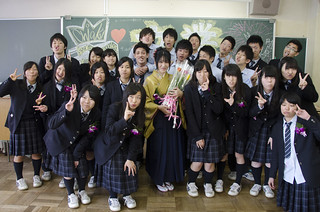
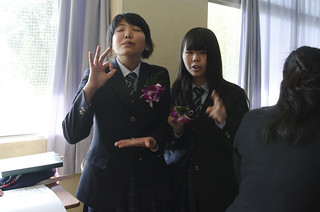
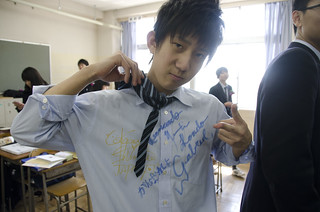
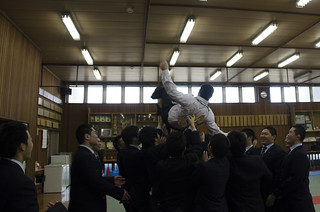
Anyway, sorry for utter lack of posts, but I’ve been doing a lot of other-kinds-of-writing. I could post those, but I don’t think there’s much interest in half-edited lesson outlines, presentation speeches and schedule frameworks. Then again, there may be a budding market for erotic haikus and twitter reviews of leaked albums…
Great post. Enjoyed the thought process and dialog of how you guys were able to hone in on the cultural issues you faced with the school administrators and work through it and ultimately work together with them to present the school in a way that wouldn't be lame.
ReplyDeleteagreed entirely with MYB on this. great job.
ReplyDeleteExcellent post! Your tour was very well received by the Torrance delegation who was fascinated by the plain classrooms and those who couldn't go want to know more about the uniformity of the layout. You certainly had to deal with a lot of "input" on what the tour should cover and what to include in the presentation. You and Kashew did a fine job and make our TSCA board proud!
ReplyDeleteThanks, Lori